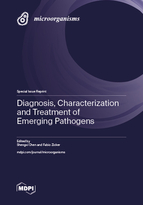Diagnosis, Characterization and Treatment of Emerging Pathogens
A special issue of Microorganisms (ISSN 2076-2607). This special issue belongs to the section "Medical Microbiology".
Deadline for manuscript submissions: closed (31 October 2023) | Viewed by 33340
Special Issue Editors
Interests: emerging pathogens; diagnosis; viral infection; inhibitor; treatment
Special Issues, Collections and Topics in MDPI journals
Special Issue Information
Dear Colleagues,
Emerging infectious diseases are perhaps the most rapidly spreading diseases. SARS-CoV-2 has infected 556 million people and has caused more than 6 million deaths worldwide. To date, people around the world are still suffering from the effects of this virus. Currently, the monkeypox virus has emerged and has spread to more than 30 countries over the course of about one month. At the same time, there are many other different emerging pathogens, examples of which include malaria, Zika, dengue, Ebola, West Nile, and diarrheagenic E. coli, all of which threaten the health of billions of people worldwide. To help fight these emerging infectious diseases, we aim to collect manuscripts focusing on emerging pathogens, including viruses, bacteria, protozoa, and fungi.
Areas of interest could include but are not limited to:
- Novel methods and strategies for the early detection of emerging pathogens.
- Characterization of specific genes or protein targets for the detection or treatment of emerging pathogens.
- Novel agents to inhibit emerging pathogens.
Dr. Shengxi Chen
Dr. Fabio Zicker
Guest Editors
Manuscript Submission Information
Manuscripts should be submitted online at www.mdpi.com by registering and logging in to this website. Once you are registered, click here to go to the submission form. Manuscripts can be submitted until the deadline. All submissions that pass pre-check are peer-reviewed. Accepted papers will be published continuously in the journal (as soon as accepted) and will be listed together on the special issue website. Research articles, review articles as well as short communications are invited. For planned papers, a title and short abstract (about 100 words) can be sent to the Editorial Office for announcement on this website.
Submitted manuscripts should not have been published previously, nor be under consideration for publication elsewhere (except conference proceedings papers). All manuscripts are thoroughly refereed through a single-blind peer-review process. A guide for authors and other relevant information for submission of manuscripts is available on the Instructions for Authors page. Microorganisms is an international peer-reviewed open access monthly journal published by MDPI.
Please visit the Instructions for Authors page before submitting a manuscript. The Article Processing Charge (APC) for publication in this open access journal is 2700 CHF (Swiss Francs). Submitted papers should be well formatted and use good English. Authors may use MDPI's English editing service prior to publication or during author revisions.
Keywords
- emerging pathogens
- detection
- characterization
- treatment
- target
- inhibitor








